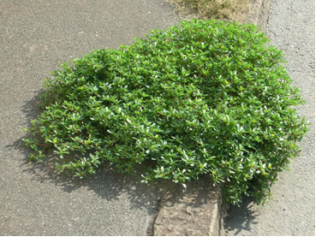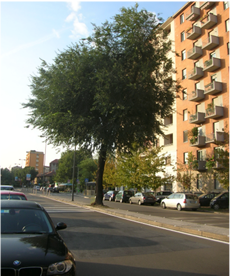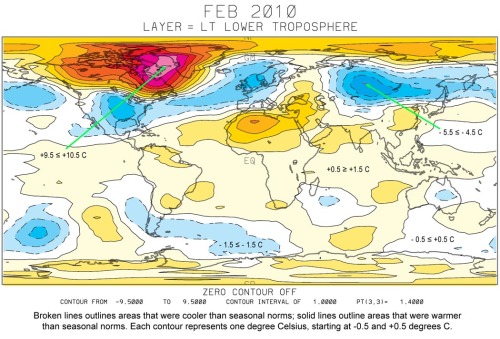Today, we have a guest post by Luigi Mariani who is Senior Agrometeorologist with experience in applied meteorology, climatology and mathematical modeling of agro-ecosystems at the Università degli Studi di Milano. It starts as follows
Figure caption– Two examples of heroic vegetation in urban areas. On the top the grass Portulaca oleracea L. and on the bottom the tree Ulmus pumila L. (pictures taken in Milano – Italy).
CO2 as carbon fertilizer for plants – effects on surface global temperatures
By Luigi Mariani
Many things have increased almost monotonously after the end of the Little Ice Age (not only the atmospheric level of CO2 but also the global population, the agricultural production, the solar activity, the global plant biomass, the number of cows and so on). This writing reports some reflections on the effects of terrestrial plant biomass increase on global climate and has been written in order to request suggestions and critics.
The colonization of terrestrial environments by vascular plants began during the Cambrian, about 500 millions of years ago (at that time CO2 levels were 20-30 times the present values) and it is possible to hypothesize an active evolution of plant associations which modified the environment in order to maintain their dominant presence in a growing number of habitats, until a coverage of the main part of the terrestrial areas during warm (greenhouse) phases. Taking into account the Liebig’s law of the minimum it is possible to think that this expansion was locally limited by the availability of chemical elements (first of all nitrogen and phosphorous) but the only real global constraint against the expansion of vegetation has been probably represented by the advent of the glacial periods, from the carboniferous glaciation (380 millions of years ago) until the 15 Pleistocene glaciations (last 2.5 millions of years).
In order to interpret the global vegetation expansion a key element is represented by the homeostasis which is the property of a system that regulates its internal environment and tends to maintain a stable, constant condition of properties like temperature or pH (http://en.wikipedia.org/wiki/Homeostasis). The homeostasis is fundamental for vegetation, natural and cultivated, in order to achieve its final aim which is the reproduction. Clearly homeostatic are for example the effects of closed canopies which maintain stable values of soil temperature (avoiding excesses, negative for roots and microbial activities) and exert a stabilizing effect on the atmospheric canopy layer (limiting evapotranspirational losses and favor the stomatal uptake of CO2 released by soil microbial activities).
The above-mentioned processes are active at microscale but relevant effects on macroscale are present due to the close coupling mechanisms among scales. A naive expression of this phenomenon is the daisyworld example with a planet that rules its albedo changing the % of black and white daisies, an example that pertains to the Gaia hypothesis (http://en.wikipedia.org/wiki/Gaia_hypothesis). Moreover a similitude could be established with the ENSO syndrome, where a boundary layer phenomenon (the abrupt warming of oceanic surface) triggers deep convection propagating El Niño signal to the free atmosphere of the whole planet (ITCZ, Hadley cell, Westerlies, monsoons are affected and the final result is, for example, given by the abrupt global warming of 1998).
After these general presuppositions I’d like to list the following elements:
1) simulations made with the low resolution spectral GCM Puma show that a world completely covered in vegetation would be much warmer – many degrees – compared to a desert world (the work is Planet Simulator: Fraedrich et al, 2005. Green planet and desert word,– http://www.mi.uni-hamburg.de/fileadmin/files/forschung/theomet/planet_simulator/downloads/plasim_mz_2.pdf). By the way this simulation takes into account the following effects of vegetation on climate: surface albedo, surface roughness and soil hydrology.
2) obviously the Fraedrich’s et al work doesn’t take into account the mesoscale effect on cloud coverage which are relevant on global climate because water vapor recycled from evapotranspiration is the main component of the continental precipitation. These effects were analyzed by
Pielke Sr., R.A., 2001: Influence of the spatial distribution of vegetation and soils on the prediction of cumulus convective rainfall. Rev. Geophys., 39, 151-177. https://pielkeclimatesci.files.wordpress.com/2009/10/r-231.pdf
Pielke, R.A. Sr., J. Adegoke, A. Beltran-Przekurat, C.A. Hiemstra, J. Lin, U.S. Nair, D. Niyogi, and T.E. Nobis, 2007: An overview of regional land use and land cover impacts on rainfall. Tellus B, 59, 587-601.
https://pielkeclimatesci.files.wordpress.com/2009/10/r-315.pdf
Pielke, R.A. and R. Avissar, 1990: Influence of landscape structure on local and regional climate. Landscape Ecology, 4, 133-155. https://pielkeclimatesci.files.wordpress.com/2009/09/r-107.pdf
4) paleo-atmospheric ice core measurements show an increase of the global ecosystem productivity for the Last Glacial Maximum (LGM) vs. Pre Industrial Holocene (PIH) of about 25 / 40% and model simulations give a coherent value of +30%. This increase is probably referred only to terrestrial ecosystems because the marine ones show only marginal variations in the transition from LGM to PIH (Prentice I.C., Harrison P., Bartlein P.J., 2011. Global vegetation and terrestrial carbon cycle changes after the last ice age, New Phytologist (2011) 189: 988–998 – see comments at http://www.co2science.org/articles/V14/N34/EDIT.php)
5) simulations of ancient cereals productions (Araus et al., 2003. Productivity in prehistoric agriculture: physiological models for the quantification of cereal yields as an alternative to traditional Approaches, Journal of Archaeological Science 30, 681–693) show that the transition of CO2 from pre-industrial 275 ppmv to 350 ppmv increase by 40% the cereal production (and with them, I guess, the production of many natural or cultivated C3).
6) the abovementioned increases of vegetation productivity are questioned by authors that hypothesize a limitation due to other nutrients like nitrogen and phosphorous (Korner C. 2006. Plant CO2 responses: an issue of definition, time and resource supply. New Phytologist 172: 393–411). Nevertheless a relevant global plant biomass increase is stated by satellite data (global net ecosystem productivity from 1982 to 1999 by 6% -> Source: Robert Simmon, NASA Earth Observatory, based on data provided by the University of Montana Numerical Simulations Terradynamic Group (NTSG). http://earthobservatory.nasa.gov/Features/GlobalGarden/).
7) a diagram of NASA earth observatory shows that the GW is largely terrestrial (http://earthobservatory.nasa.gov/IOTD/view.php?id=76975&src=eoa-iotd).
8) a metrics suggested by Roger Pielke Sr. to look at the energetic role of vegetation is represented by the moist enthalpy (alias equivalent temperature). For example daytime temperatures are generally reduced over crops during the growing season (even with lower albedo) but the moist enthalpy is higher. See in particular:
Pielke Sr., R.A., C. Davey, and J. Morgan, 2004: Assessing “global warming” with surface heat content. Eos, 85, No. 21, 210-211.
https://pielkeclimatesci.files.wordpress.com/2009/10/r-290.pdf
Davey, C.A., R.A. Pielke Sr., and K.P. Gallo, 2006: Differences between near-surface equivalent temperature and temperature trends for the eastern United States – Equivalent temperature as an alternative measure of heat content. Global and Planetary Change, 54, 19.32
https://pielkeclimatesci.files.wordpress.com/2009/10/r-268.pdf
Fall, S., N. Diffenbaugh, D. Niyogi, R.A. Pielke Sr., and G. Rochon, 2010: Temperature and equivalent temperature over the United States (1979 . 2005). Int. J. Climatol., DOI: 10.1002/joc.2094.
https://pielkeclimatesci.wordpress.com/iles/2010/02/r-346.pdf
A possible deduction from such evidences is that when CO2 increases, also plant biomass grows, so:
1. More water vapour is input so that the latitudinal transport of energy toward the poles is enhanced and also enhanced is the greenhouse effect
2. the global albedo is decreased (the albedo of a desert is higher than that of a ground covered with vegetation).
3. soil water reservoir is emptied faster, so summer drought begins earlier and the H/LE ratio is also increased; on the other hand mesoscale precipitation is enhanced by vegetation, with a decrease of H/LE.
As a final result of this causal chain the H term of the surface energy balance is emphasized and accordingly an increase of air temperature is measured by ground weather stations, giving rise to the general deduction that CO2 could give a positive feed-back on surface global temperatures acting as “fertilizer” for plants.
Two main questions comes from this reasoning:
1. it is possible to have an idea of the significance and of the overall relevance of this phenomenon?
2. Do IPCC GCM simulations take into account the increase in plant biomass, which probably took place in the last 150 years?




